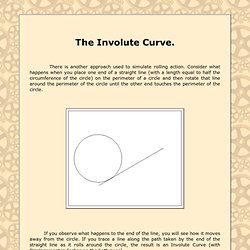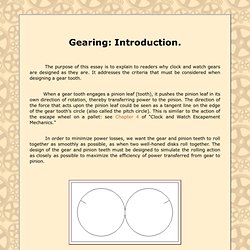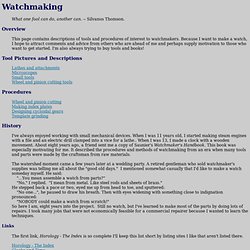

The Involute Curve. Select this link to see the chart that was used to create this graph.

The Cycloidal Curve. In order to simulate the rolling action of two discs, we must consider the path traced by a point on the edge (circumference) of one of the discs.

First consider the path traced by a point on the edge of a circle that rotates in a stationary position. In this drawing, the point is where the small line meets the edge of the circle. The path is obviously that of a circle. Now consider the path traced by this point when the circle is rolling on a horizontal plane. (I have deliberately exaggerated the horizontal movement of the circle in the next drawing to illustrate more clearly the path of the point on the circle.) Gearing: Introduction. The purpose of this essay is to explain to readers why clock and watch gears are designed as they are.

It addresses the criteria that must be considered when designing a gear tooth. When a gear tooth engages a pinion leaf (tooth), it pushes the pinion leaf in its own direction of rotation, thereby transferring power to the pinion. The direction of the force that acts upon the pinion leaf could be seen as a tangent line on the edge of the gear tooth’s circle (also called the pitch circle). This is similar to the action of the escape wheel on a pallet: see Chapter 4 of "Clock and Watch Escapement Mechanics. " In order to minimize power losses, we want the gear and pinion teeth to roll together as smoothly as possible, as when two well-honed disks roll together. Gears and Clocks. National Institute of Standards and Technology (NIST) The Time It all started with gears!

I have an interest in gears. Most clocks require gears, so why not build a clock? This was also an experiment in rapid model design that turned out to be not so rapid. I plan to build a clock from acrylic plastic. Watchmaking. What one fool can do, another can. -- Silvanus Thomson.

Overview This page contains descriptions of tools and procedures of interest to watchmakers. Because I want to make a watch, I hope to attract comments and advice from others who are ahead of me and perhaps supply motivation to those who want to get started. Gear Design and Engineering Data Knowledge Menu. Gear Design Intro, by EPI Inc. This section contains information on several important topics with respect to the properties of gears and the loads imposed on them in a geared transmission system. It will be worthwhile to take the time to read through these four pages if you are truly interested in knowing how a geared system functions.
Introduction to Gears This section explains the meaning of a few basic gear terms, including ratio, pitch diameter, diametral pitch, pressure angle, line of contact, involute profile, tangential force and separation force. The purpose of gears is to transmit uniform rotary motion from one shaft to another, and usually to turn the driven shaft at a different speed than the driving shaft. The difference between input and output speed is known as the RATIO, and can be calculated by OUTPUT SPEED ÷ INPUT SPEED, or by OUTPUT GEAR TOOTH COUNT ÷ INPUT GEAR TOOTH COUNT or by OUTPUT GEAR PITCH DIAMETER ÷ INPUT GEAR PITCH DIAMETER. Basic Gear Terminology Tangential Force = 7500 ÷ 1.75 = 4286 lbs. Gear template generator. This free online gear template generator is designed for making scale accurate paper gear templates which you can glue onto wood and then cut out with a bandsaw.

I recommend printing the gears with an ink jet printer. Even cheap ink jet printers print very scale accurate but Not all laser printers are accurate. You can still access the old (pre 2015) Flash based gear geberator Getting the printout to scale correctly, avoiding cropping Different browsers print at different scales depending on browser type and printer configuration. Use an ink jet printer I recommend using an ink jet printer. Printing the gear templates To print the gear template, use the 'Print' button, instead of printing the web page from the browser. The gear generator program that I created and sell doesn't need the scale calibration, and can paginate across many pages for larger gears.
Some notes about gear design and this gear template generator This gear template generator generates shapes for involute spur gears.